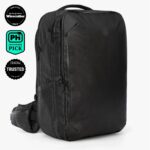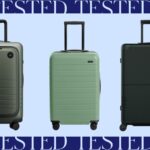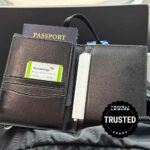Packing your luggage for a long trip can feel overwhelming. You want to bring everything you need without carrying too much.
But how do you strike the perfect balance? Imagine opening your suitcase and finding exactly what you need, right when you need it. No stress. No extra weight. You’ll discover simple, smart tips to pack efficiently and confidently. Ready to make your next trip easier from the moment you zip your bag?
Let’s dive in.
Choosing The Right Luggage
Choosing the right luggage is key for a long trip. It affects how easy it is to move around. The right bag keeps your things safe and organized. It also fits travel rules and your style.
Suitcase Vs Backpack
A suitcase has wheels and a hard or soft shell. It is easy to roll in airports and cities. It keeps clothes neat and flat. A backpack is carried on your back. It is good for uneven roads and crowded places. Backpacks let you keep your hands free. Pick a suitcase for smooth travel. Choose a backpack for adventure and flexibility.
Size And Weight Limits
Check the size rules of airlines before packing. Each airline has limits for carry-on and checked bags. A bag too big or heavy can cause extra fees. A smaller bag is easier to carry and store. Make sure your luggage fits these limits to save money. Weight is important. A heavy bag is hard to move and may exceed limits.
Durability And Features
Durable bags last longer and protect your belongings. Look for strong zippers and sturdy handles. Waterproof materials help in rainy weather. Extra pockets and compartments keep items organized. Some bags have locks for security. Smooth wheels make moving easier. Choose luggage that fits your trip style and needs.
Planning Your Packing List
Planning your packing list is the first step for a successful long trip. It helps avoid forgetting important items and keeps your luggage light. A clear list saves time and stress before travel. Focus on what you really need for your destination and trip length.
Essentials For Long Trips
Start with basic items you cannot do without. Passport, tickets, and travel documents come first. Carry a small first aid kit for emergencies. Include medications and any prescriptions. Pack a reusable water bottle and snacks for the journey. A travel pillow and eye mask add comfort. Keep a small bag for dirty laundry.
Clothing Selection
Choose clothes based on weather and activities. Pick versatile pieces that mix and match easily. Layering helps with temperature changes. Bring enough underwear and socks for several days. Include a light rain jacket or umbrella. Shoes should be comfortable and suitable for walking. Avoid heavy or bulky items to save space.
Toiletries And Personal Care
Pack travel-sized toiletries to save room. Toothbrush, toothpaste, and deodorant are a must. Bring sunscreen and insect repellent if needed. A small comb or brush keeps hair neat. Include feminine hygiene products if required. Use leak-proof containers to prevent spills. Carry hand sanitizer and wet wipes for cleanliness.
Electronics And Accessories
Bring only necessary gadgets and chargers. A smartphone and power bank are essential. Consider a universal adapter for foreign plugs. Headphones help pass time during travel. A camera can capture special moments. Keep all devices in a padded case for protection. Don’t forget extra memory cards or batteries.
Packing Techniques
Packing techniques make a big difference on a long trip. They help save space and keep things tidy. Good packing means less stress and easy access to your items. Use smart methods to fit more clothes and essentials in your luggage.
Rolling Vs Folding Clothes
Rolling clothes saves more space than folding. It also reduces wrinkles on your clothes. Roll t-shirts, pants, and light fabrics tightly. Fold bulky items like sweaters to keep their shape. Try both methods to see what works best for your clothes.
Using Packing Cubes
Packing cubes keep your luggage organized and neat. They separate different types of clothes or items. Use cubes to group shirts, underwear, and accessories. Cubes make it easy to find things fast. They also help compress clothes for extra space.
Maximizing Space
Fill every corner of your luggage to save space. Put shoes inside shower caps or bags. Use small items like socks to fill gaps. Place heavy items at the bottom for balance. Avoid overpacking by only taking what you need.
Organizing By Category
Sort your items by category before packing. Keep clothes, toiletries, and electronics separate. This saves time when unpacking or searching for something. Use clear bags or packing cubes for each category. It keeps your luggage tidy and easy to manage.
Weight Distribution And Balance
Packing luggage for a long trip needs careful weight distribution and balance. This helps you carry your bag comfortably and avoid strain on your back or shoulders. A well-balanced bag also makes traveling easier, especially when moving through airports or stations.
Think about how you place items inside your luggage. Heavy things should go in the center or near the wheels. Light items should fill the gaps around them. Proper packing keeps your bag steady and less likely to tip over.
Evenly Distributing Weight
Spread heavy items evenly on both sides of your bag. Avoid putting all weight on one side. This balance stops your bag from leaning and makes it easier to handle. Place dense items like shoes or books at the bottom. Fill spaces with clothes to keep everything tight.
Avoiding Overpacking
Overpacking adds extra weight and makes your bag hard to carry. Stick to essentials and plan your outfits. Use packing cubes to organize clothes and prevent bulk. Less weight means less effort and faster movement during travel.
Accessibility Of Important Items
Keep important items like passports, tickets, and chargers easy to reach. Use outer pockets or top compartments for these. Avoid burying essentials deep inside your bag. Quick access reduces stress and saves time at checkpoints.
Security And Safety Tips
Keeping your luggage safe is key for a long trip. Security and safety tips help protect your belongings. Small actions can stop big problems. Follow easy steps to secure your bags and feel calm on your journey.
Using Locks And Tags
Use strong locks on all zippers and compartments. TSA-approved locks allow airport security to check bags without damage. Bright luggage tags help identify your bags fast. Write your name and phone number on the tags. Avoid showing your home address for privacy.
Protecting Valuables
Keep valuable items close to your body during travel. Use a small bag or pouch inside your main luggage. Avoid packing expensive items in checked bags. Electronics, jewelry, and money should stay in carry-on bags. Consider wrapping electronics in soft cloth to avoid damage.
Travel Insurance Considerations
Travel insurance covers lost, stolen, or damaged items. Check what your policy includes before you pack. Some plans cover electronics and luggage replacement. Keep receipts of valuable purchases as proof. Carry a copy of your insurance details with you.
Special Considerations For Different Trips
Packing for a long trip needs more than just stuffing clothes into a bag. Different trips require different items and planning. Knowing what to pack helps avoid extra baggage and last-minute stress. This section covers special tips for business trips, adventure travel, and family vacations. Each type needs a unique packing approach.
Business Travel Packing
Business trips need clothes that look sharp and professional. Choose wrinkle-free fabrics to save time on ironing. Pack a pair of dress shoes and a backup pair in case of emergencies. Include chargers, adapters, and any work devices. Keep documents and business cards handy. A small toiletry bag with essentials is enough. Avoid bulky items to keep luggage light.
Adventure And Outdoor Trips
Adventure trips require gear for safety and comfort. Pack durable clothes that dry quickly. Include waterproof jackets and sturdy boots. Bring necessary equipment like a first aid kit and navigation tools. Carry enough water and snacks for the trail. Use compression bags to save space. Keep essentials accessible to avoid unpacking often.
Family Travel Tips
Family trips need more careful planning for everyone’s needs. Pack clothes in separate bags for each family member. Bring extra snacks and entertainment for kids. Include a small medical kit with basic medicines. Use packing cubes to organize items better. Prepare for weather changes with layers. Always have a backup plan for lost or forgotten items.
Final Checks Before Departure
Before you leave for a long trip, final checks are very important. These last steps help avoid problems at the airport. You can travel with peace of mind if your luggage is ready and meets all rules. Take a moment to review your bags carefully. This ensures a smooth start to your journey.
Weighing Your Luggage
Use a scale to weigh your bags. Many airlines have weight limits for checked and carry-on luggage. Exceeding these limits can cause extra fees or delays. Weigh each bag and adjust if needed. This step helps avoid surprises at check-in.
Checking Airline Regulations
Each airline has rules about luggage size and contents. Check the website for the latest guidelines. Make sure your bags follow size and weight rules. Also, review what items you cannot bring. This saves time and stress during security checks.
Last-minute Item Additions
Think about what you might need last minute. Add chargers, travel documents, and medications to your carry-on. Pack snacks or a water bottle for the trip. Double-check your essentials so nothing important is left behind. These small steps make your travel easier.
Frequently Asked Questions
How Do I Choose The Right Luggage For A Long Trip?
Pick luggage that is lightweight, durable, and fits your trip length and activities.
What Are The Best Packing Tips For A Long Trip?
Roll clothes, use packing cubes, and pack versatile outfits to save space.
How Can I Keep My Luggage Organized During Travel?
Use compartments, label bags, and keep essentials accessible for easy finding.
What Items Should I Always Pack For A Long Journey?
Include toiletries, chargers, a first-aid kit, and weather-appropriate clothes.
How Do I Avoid Overpacking For An Extended Trip?
Plan outfits ahead, pack only what you need, and leave extras behind.
Conclusion
Packing luggage for a long trip takes some planning. Choose only what you truly need. Roll clothes to save space and avoid wrinkles. Use packing cubes to stay organized. Keep important items easy to reach. Remember, packing light makes travel easier and less stressful.
Enjoy your trip with everything you need close by. Simple steps help you travel smart and comfortable. Safe travels and happy packing!





